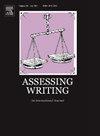以语言特征为指标,对中学英语学习者科学报告写作质量的结构方程研究
IF 5.5
1区 文学
Q1 EDUCATION & EDUCATIONAL RESEARCH
引用次数: 0
摘要
虽然探究语言特点与 L2 写作质量之间的关系是一个长期的研究方向,但很少有学者关注语言特点在评估以英语为母语的科学报告写作质量方面的预测价值。本研究以英美中学 106 名香港中文英语学习者撰写的科学报告为基础,探讨了词法和句法复杂性与写作质量的关系,为现有文献提供了补充。研究采用自然语言处理工具提取语言复杂性特征的计算指数,然后使用结构方程建模(SEM)方法研究其预测能力。根据若干拟合优度标准,确认了预期结构的有效性。SEM 分析表明,词汇复杂性(即基于文本的复杂性:词汇范围和学术词汇;心理语言复杂性:词汇熟悉度和习得年龄评级)、词汇多样性(即 MTLD 和 VocD)和句法复杂性(即每个 T 单元的句子和从句的平均长度)对写作质量有预测作用。然而,词汇多样性和句法复杂性与写作质量的关系是以词汇复杂性为中介的。本文讨论了在 EMI 教育背景下科学报告写作评估和教学法的意义。本文章由计算机程序翻译,如有差异,请以英文原文为准。
A structural equation investigation of linguistic features as indices of writing quality in assessed secondary-level EMI learners’ scientific reports
While inquiry into the relationship between linguistic features and L2 writing quality has been a long-standing line of research, little scholarly attention has been drawn to the predictive value of linguistic features in assessing the writing quality of English-medium scientific report writing. This study adds to the existing literature by examining the relation of lexical and syntactic complexity to writing quality, based on 106 scientific reports composed by Hong Kong Chinese learners of English in EMI secondary schools. Natural language processing tools were employed to extract computational indices of linguistic complexity features, followed by the use of a structural equation modeling (SEM) approach to investigate their predictive power. The validity of the anticipated construct was confirmed based upon several goodness-of-fit criteria. The SEM analysis indicated that writing quality was predicted by lexical sophistication (i.e., text-based complexity: word range and academic words; psycholinguistic complexity: word familiarity and age-of-acquisition ratings), lexical diversity (i.e., MTLD and VocD), and syntactic complexity (i.e., mean length of sentence and dependent clauses per T-unit). However, the relation of lexical diversity and syntactic complexity to writing quality was mediated by lexical sophistication. Implications for scientific report writing assessment and pedagogy in EMI educational contexts are discussed.
求助全文
通过发布文献求助,成功后即可免费获取论文全文。
去求助
来源期刊

Assessing Writing
Multiple-
CiteScore
6.00
自引率
17.90%
发文量
67
期刊介绍:
Assessing Writing is a refereed international journal providing a forum for ideas, research and practice on the assessment of written language. Assessing Writing publishes articles, book reviews, conference reports, and academic exchanges concerning writing assessments of all kinds, including traditional (direct and standardised forms of) testing of writing, alternative performance assessments (such as portfolios), workplace sampling and classroom assessment. The journal focuses on all stages of the writing assessment process, including needs evaluation, assessment creation, implementation, and validation, and test development.
 求助内容:
求助内容: 应助结果提醒方式:
应助结果提醒方式:


